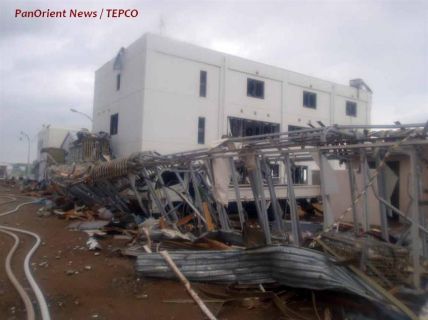|
|
Environment
High Radiation Data ``Concealed`` by TEPCO
Sunday, May 15, 2011

Tokyo - (PanOrient News) The operator of the crippled Fukushima Daiichi nuclear power plant, Tokyo Electric Power Co., or TEPCO, concealed data showing surges in radiation levels at the Fukushima No. 1 nuclear power plant in March, one day before a hydrogen explosion injured seven workers, the daily Asahi Shimbun reported.
The paper cited a 100-page internal TEPCO report containing minute-to-minute data on radiation levels at the plant as well as pressure and water levels inside the No. 3 reactor from March 11 to April 30.
This is certain to make another blow to the company image that is shattered by its handling of the worst nuclear accident in Japan's history.
The unpublished information shows that at 1:17 p.m. on 13 March, 300 millisieverts of radiation per hour was detected inside a double-entry door at the No. 3 reactor building. At 2:31 p.m., the radiation level was measured at 300 millisieverts or higher per hour to the north of the door. Both levels were well above the upper limit of 250 millisieverts for an entire year under the plant's safety standards for workers.
“But the workers who were trying to bring the situation under control at the plant were not informed of the levels.”
When the Great East Japan Earthquake struck on March 11, the No. 1, No. 2 and No. 3 reactors all automatically shut down. But the tsunami incapacitated the emergency generators, leading to a total power failure that prevented the cooling systems from functioning.
TEPCO's public relations department reportedly said their company has informed the public that significant levels of radiation have been detected at the plant, , but it disclose specific data after a thorough review of the figures is completed.
Critics said TEPCO's decision to conceal the data must be scrutinized, and such important data should have been immediately released to ensure the safety of the public and workers at the plant, especially in an emergency like the Fukushima nuclear accident. Failure to release radiation data in the early stages of the disaster is reported to have delayed the evacuations of communities near the plant.
Calls are mounting by nuclear power experts for a thorough examination of TEPCO's unpublished data, and also verbal communications of those involved, instructions issued by the central government and TEPCO, and the communication structure between management and workers at the plant.
Recent additional disclosures have raised doubts about the company's so-called "road map" for ending the crisis. Measurements from a recently installed water gauge provided conclusive evidence that the condition of the No. 1 reactor at the plant was much more serious than TEPCO officials have acknowledged until now.
They admitted on May 12 that a "meltdown" had occurred in the No. 1 reactor. Fuel rods had melted, and the molten fuel accumulated and caused small cracks at the bottom of the reactor pressure container, they said.
Until now, TEPCO officials only said that fuel rods were partially damaged and compiled a work schedule in April for restoring a stable cooling system based on that assumption.
Moreover, a robot has detected highly dangerous levels of radiation in the Fukushima No. 1 nuclear power plant's No. 3 reactor building according to local reports, indicating further safety measures will be needed before workers can enter the structure.
According to TEPCO, the remote-controlled PackBot robot on Tuesday found radiation levels in the northwestern section of the building of 49 to 120 millisieverts per hour, which would pose a threat to human workers.
TEPCO's priority now is to remove debris with robots, or sealing up the radiation-contaminated debris in the building, then to starts work to stabilize the damaged reactors.
The situation is unlikely to get worse, however, TEPCO said citing that the temperature in the pressure vessel remains stable at 100 C to 120 C.
PanOrient News
© PanOrient News All Rights Reserved.
|
|

